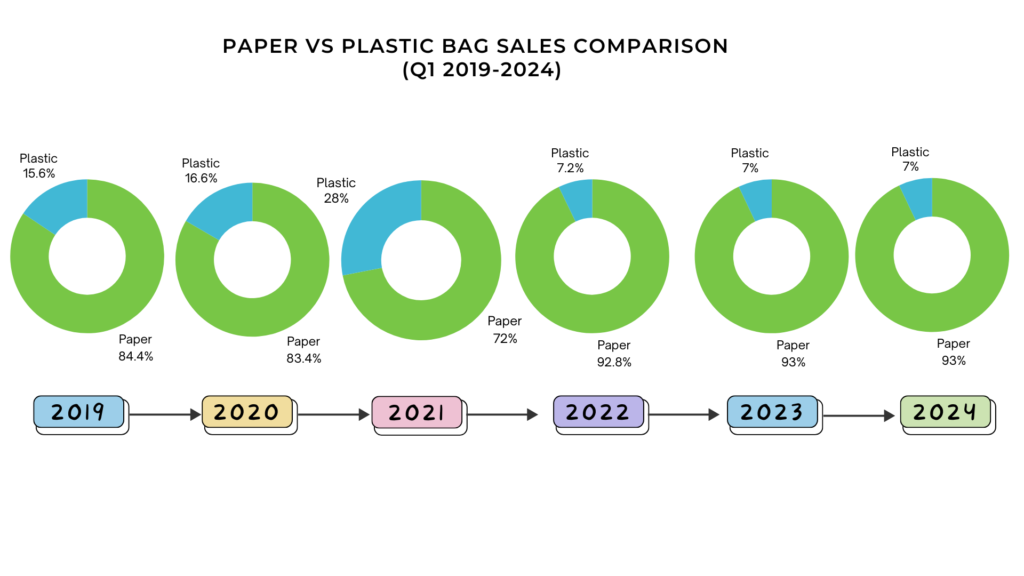The sales landscape for carrier bags has undergone significant transformations over the past few years. At the forefront of this change is the evolving preference for paper vs plastic bags. By examining the data from Carrier Bag Shop between 2019 and 2024, we uncover the key trends and factors driving this shift. This analysis not only reflects the impact of environmental awareness and regulatory changes but also highlights the broader implications for businesses adapting to these new consumer preferences. Let’s dive into the year-by-year sales performance and explore why paper bags have surged in popularity amidst the declining usage of plastic bags.
Yearly Sales Trends of Paper Bags vs Plastic Bags
The comparison in the diagram below shows the percentage of total sales for the value paper bag vs the plastic vest bag.

2019
In 2019, paper bags made a significant impact, contributing 4% of the overall total sales, while plastic bags accounted for a mere 1%. This initial data indicates a consumer preference leaning towards more eco-friendly options, even before major regulatory changes.
2020
In 2020, paper bags showed a slight decrease by 1%, whilst plastic bags increased by 1%. There wasn’t a significant change this year.
2021
In 2021, the preference for paper bags dropped by 11%, whereas plastic bag sales saw an increase by 12%. We see a shift this year, but paper bags still remain the preferred bag of choice. The increase in plastic bags may have been due to an increase in the number of takeways during the pandemic, where this type of bag would have been a cheaper alternative to paper for those struggling with costs during this period.
2022
2022, marks a pivotal year with the introduction of the plastic bag tax in April. The sales data for Q1 shows a significant increase in paper bag sales compared to that of plastic. This regulatory change likely further discouraged the use of plastic bags.
2023
In 2023, the trend continues with paper maintaining a higher market share, while plastic bags stayed similar to 2022. The stabilisation of these figures suggests that c onsumer habits have adjusted to the regulatory environment.
2024
The most recent data from 2024 shows a continued preference for paper, with their market share increasing to 8% of total overall bag sales. Plastic bags remained steady at 1% of total overall bag sales, indicating a sustained impact of the plastic bag tax and a solidified consumer shift towards more sustainable options.
Why Paper Bags Became More Popular
Let’s take a look at the possible factors that may have lead to the rise in paper bag popularity over plastic:
Environmental Awareness
Firstly, increasing public awareness about the environmental impact of plastic pollution has driven consumers to opt for more sustainable alternatives. Paper bags, being biodegradable and recyclable, are perceived as more environmentally friendly than plastic bags, which can take hundreds of years to decompose. With that being said, there are biodegradable plastic bags available which provide a more eco-friendly option if your opting for plastic bags.
Government Regulations
Secondly, the plastic bag tax introduced in the UK in April 2022 significantly impacted consumer behaviour. By imposing a levy on plastic bags, the government aimed to reduce their usage and encourage the adoption of reusable or eco-friendly alternatives. This policy directly influenced the steady decline in plastic bag sales and bolstered the preference for paper bags.
Corporate Responsibility
Many companies are increasingly adopting corporate social responsibility (CSR) initiatives that focus on sustainability. Retailers and businesses have been promoting the use of paper bags to align with their environmental goals and appeal to eco-conscious consumers.
Consumer Preferences
As consumers become more educated about the ecological footprint of their choices, there is a growing trend towards purchasing products that have less of an environmental impact. Paper bags, often marketed as an eco-friendly option, resonate well with this shift in consumer preferences. Other eco-friendly options include reusuable bags such as jute or cotton , which make great bags for life.
Marketing and Branding
Paper bags offer better branding opportunities. Companies can easily print their logos and promotional messages on paper bags, turning them into effective marketing tools. This has made paper bags a popular choice among businesses looking to enhance their brand visibility while supporting environmental sustainability.
Perceived Quality
Lastly, many consumers perceive paper bags as being of higher quality and more premium compared to plastic bags. This perception is often reinforced by the sturdiness and aesthetic appeal of paper bags, which can handle a variety of weights and uses without tearing as easily as cheaper plastic bags might.
Conclusion
The analysis of Carrier Bag Shop’s sales data from 2019 to 2024 highlights a clear and sustained preference for paper bags over plastic bags, driven by both consumer preferences and regulatory measures. The plastic bag tax has effectively discouraged the use of plastic bags, as evidenced by the consistently low sales figures for vest bags. Moving forward, it’s likely that the market will continue to favour sustainable packaging solutions, reflecting broader environmental trends and legislative support.
Understanding these trends can help businesses better anticipate consumer demands and adapt their product offerings to align with the ongoing shift towards sustainability. The trends observed from 2019 to 2024 provide valuable insights for the future, indicating that the shift towards eco-friendly packaging is not just a temporary phase but a long-term transformation in consumer behaviour and market dynamics.
Related articles
The environmental impact of paper bags


